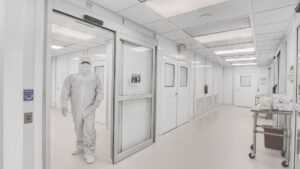21 Dec USP 797 Cleanrooms and Compliance
USP 797 is a standard established by the United States Pharmacopeia Convention (USP), a scientific non-profit organization dedicated to ensuring the quality of the American drug/ pharmaceutical supply, USP 797 also outlines the required procedures for compounding sterile drug preparations.
A modular cleanroom building enclosure is a structure that can be built to comply with USP 797.
USP 797 is the standard for the design and construction of pharmaceutical manufacturing facilities. It was developed by the United States Pharmacopeial Convention (USP), and it has been adopted by the Food and Drug Administration (FDA). The purpose of USP 797 is to ensure that manufacturing facilities are designed, constructed, and operated in a way that prevents contamination of drug products during processing.
The modular clean room building enclosure provides a barrier between outside environments and the interior of the facility. The barrier is not required to be airtight, but it should prevent dust particles from entering the facility. Clean room buildings are designed to isolate manufacturing environments from the outside world so that contamination is not possible. The USP 797 standard defines the following three types of clean rooms: –
- Class 100: (ISO 5) A room that maintains less than 100 particles of greater than 0.5 microns per cubic foot (0.5 µm/ft3) in the air.
- Class 1000:(ISO 6) A room that maintains less than 1000 particles of greater than 0.5 microns per cubic foot (0.5 µm/ft3). –
- Class 10,000: (ISO 7) a room that maintains less than 10,000 particles of greater than 0.5 microns per cubic foot (0.5 µm/ft3). Clean rooms are often used in manufacturing to help prevent cross-contamination of products.
A clean room may be designed as part of a facility or added later, depending on its purpose and function. In general, clean rooms have a positive pressure relative to the surrounding area so that air flows into the room rather than out. This helps prevent contamination by maintaining a constant airflow and preventing particulates from entering the environment.

